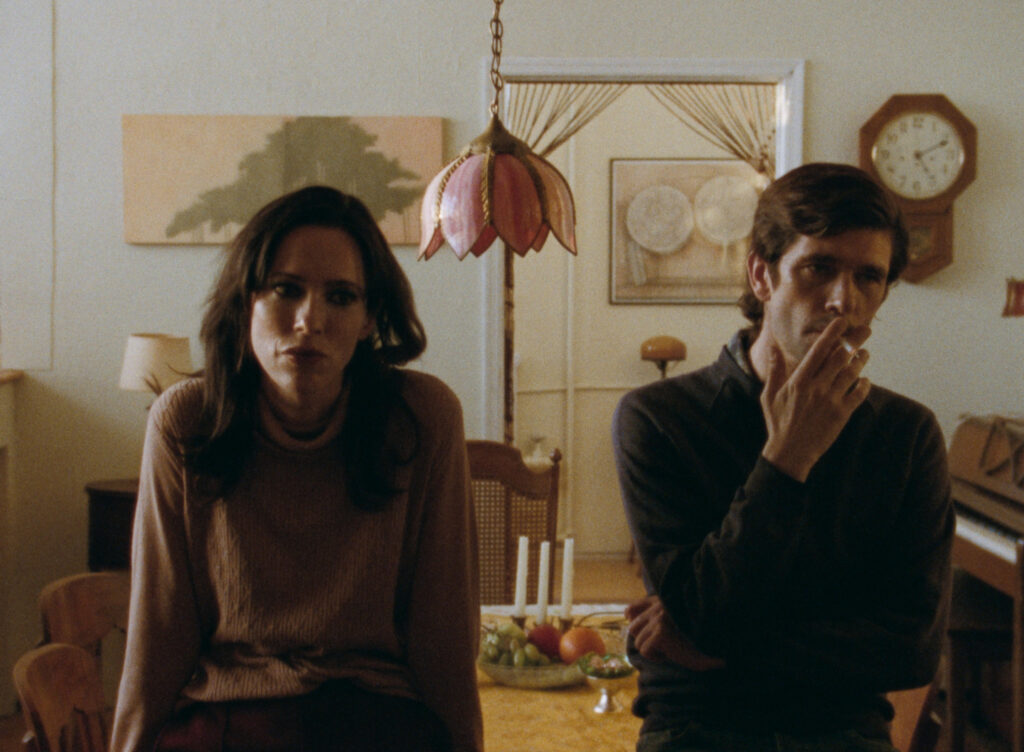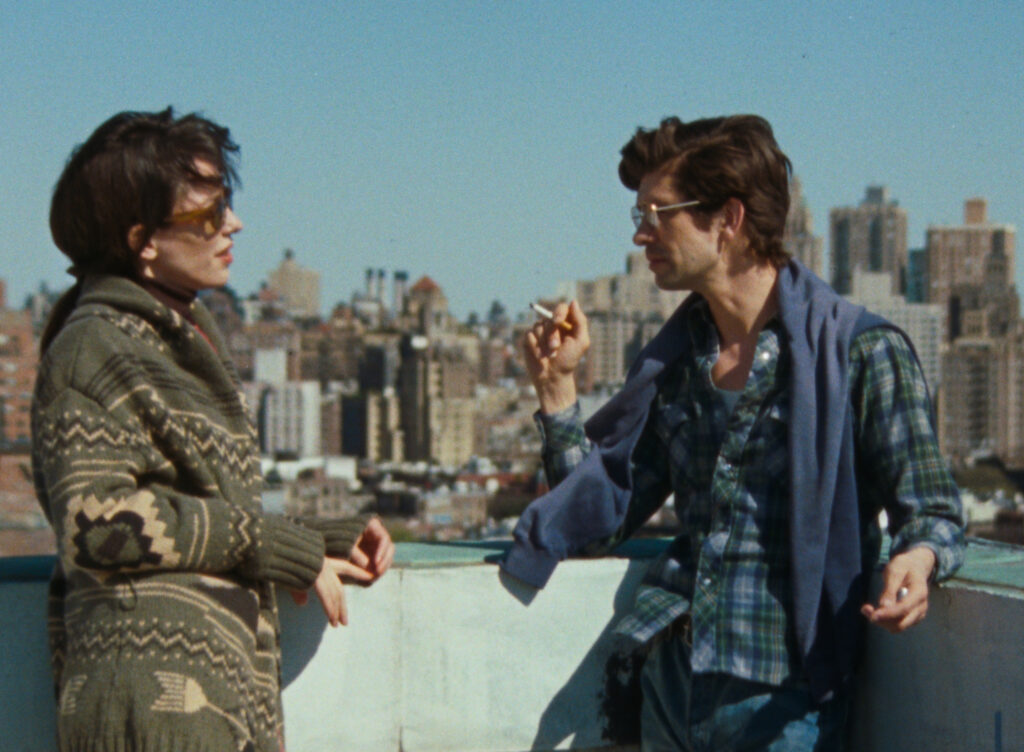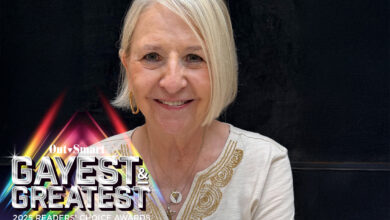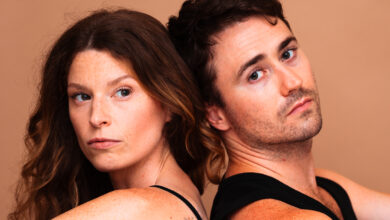A Day with Peter Hujar
A portrait of art, memory, and queer collaboration across generations.
Peter Hujar’s Day is almost an impossible movie—an adaptation of a 74-page transcript (later published into a book) for a single interview in one location between two people. Yet somehow, director Ira Sachs (Leave the Lights On, Passages) found a brilliant vision to make it work.

“I read the book when I was working in Paris on Passages with Ben Whishaw,” says Sachs. “When I picked it up, I felt very intimately connected to the text, conversation, and time. I felt like it was something that Ben and I could embark upon together as a kind of art project. The text had all the things that I look for in cinema—detail and authenticity and intimacy and emotion.”
As the opening card of the film describes, the movie takes place on December 19, 1974, when writer and journalist Linda Rosenkrantz (Rebecca Hall) sat down with photographer Peter Hujar (Ben Whishaw) and asked him to recount his previous day in great detail. What follows is an elliptical back-and-forth, revealing the New York-based photographer through the quotidian aspects of his life as a worker, friend, and artist. Their banter becomes immediately recognizable as the bond between a gay man and straight woman best friend, oscillating between serious and gossipy but always maintaining a level of intimacy. Each name mentioned becomes a constellation of worlds that Peter charted, from Susan Sontag to Allen Ginsberg to Williamqueer cinema Burroughs. It’s a brief glimpse into a world long gone, but whose reverberations persist to this day.
The film can be seen as a departure for the director, whose films have been a cornerstone of queer independent cinema. Outside of Married Life, all of his feature films have been set in contemporary times. Peter Hujar’s Day feels almost like a collision of timelines, though, not only because it’s a recorded recounting of a recounting, but also because it wears its contemporary construction. “The fact that it was 1974 was less significant than the fact that all the details seem so vivid,” says Sachs. “It’s a period film only in that the text was recorded in ’74. It was made in 2024—50 years later. The process of making this theatrical reimagination of the original dialogue conversation was as essential to me as trying to go back in time, which I wasn’t trying to do.”
The script comes directly from the written transcript, including every pause and punctuation. Yet as much as the film is a recounting of documented events, it’s much more an imagined possibility of how this encounter could have been. Dance sequences are inserted, drinks are poured, records are played. “I was staging something, and I was considering that the text is kind of the raw material for contemporary film. I was not interested in fact, but in feeling.”

That feeling permeates throughout every single frame of the film, spilling out through the macramé on the dining room table to the record player in the living room to the fur sprawled out atop the bed. Much of this detailed production design came from photos that Linda herself shared with Ira. The two quickly formed a bond over the source material and circled the same milieu—just a generation apart.
“When I read the book, I reached out to Linda on Instagram and we started a conversation that became very sweet and personal quite quickly,” says Sachs. “We had an immediate fondness for each other. I certainly don’t have the place in her life that Peter did (or does), but I think both of us connected through art and art-making, and also as two Eastern European Jewish people.”
This bond helped them become collaborators on the project, incorporating aspects of Linda within the film without becoming beholden to recreating her memories. “She read Rebecca Hall’s dialogue on a tape recorder so Rebecca could hear how Linda might say it. And she tried to answer as many questions as I might have about who was who, and what they meant to her or to Peter,” Sachs explains.
While Rebecca was able to rely on these tools from Linda to build a reference framework for her performance, there really weren’t many video recordings of Peter available. Much of Ben’s portrayal, through his affectations, gestures, and embodiment, focused on essence rather than imitation. “The essence comes through because he was working verbatim with the way Peter spoke,” says Sachs. “Every word, every comma, every addendum or change, every reshuffling of words, was true to how it was said. Or at least the words that were said in December of 1974. He didn’t need to become Peter; it’s the essence that the film is interested in.”

In a space where so many biopics attempt an embodiment of affect and gesture to resemble similarities held in the popular imagination (look no further than the upcoming Michael movie), Peter Hujar’s Day is unique in the way it pushes deeper for a truth that lies in interpretive materials. The film understands the source text as a space where truth lies in multiple possibilities, rather than aiming for an uncanny recreation of a single interpretation. This approach can be seen in the film in multiple forms, including the nonlinear timeline of events. Linda and Peter begin by recounting the morning’s events in the morning, but it quickly slips into night and then evening. For Sachs, time is more evocative of a feeling than a strict linearity.
One reason for these creative interventions is practicality. While filming an 80-minute movie in one location from a single interview transcript with two actors is a feat in itself, that didn’t start off as such a strength in the pre-production phase “That was the crisis of the film, to be honest. We had to figure out how to translate something that was most likely, in real time, quite static,” says Sachs. The solution came only a few weeks before cameras began to roll, looking at documentary portraits like Shirley Clarke’s Portrait of Jason and Andy Warhol’s Poor Little Rich Girl.
“It’s really the changing of time which creates movement from one space to another,” says Sachs. “A subject is on a couch, and then they’re on a terrace, and you don’t know how they got there. But the continuity of the dialogue is what moves you along. Ultimately, I found that my interest was in examining and playing with different forms of cinematic portraiture. Each scene of the film is a conversation between light, space, and form, and how those interact to become a motion and a narrative.”
Sachs’ next work, titled The Man I Love, sees him reteaming with Rebecca Hall to tell the story of a gay artist living in New York City in the 1980s during the AIDS epidemic, as he takes on possibly one last great role. It’s not too dissimilar to Hujar, who also passed from AIDS in the late 1980s. “The AIDS epidemic transformed my life because I came to a city that was a shell of itself,” says Sachs, “and a city that glimmered with loss as much as with beauty. I’m making a film about an artist facing the end of their life, which in some ways means I’m making a documentary. Or an autobiography.”
Peter Hujar’s Day is currently playing at the River Oaks Theatre.










